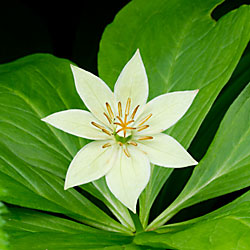Why do hostas require shade?
Hostas do not require shade, they are “shade tolerant.” There are many degrees of shade, ranging from sites that never receive any direct sunlight, like the north side of a building or the dense, low covering of large trees in a heavily wooded site, to open, filtered and dappled light coming through the canopy of smaller leaved, more open trees. Also, direct sunlight in the afternoon, between noon and 4:00 p.m., is much more intense than morning or late afternoon sun.
The amount and type of shade will affect the selection, placement and performance of hostas. In general, avoid placing them where they would receive sun between noon and 4:00 p.m. Yellow or gold-leaved hostas need some sun to develop their brightest coloration. It is frequently stated that a yellow hosta will brighten up a dark spot. This is true, but they often don’t do well in such locations, as they find them too shady. The blue coloring of some hosta leaves, called pruinose or glaucous (characterized by a waxy, silvery coating), will last longer if the plants are grown in light shade. In general, green-leaved hostas can take a fair amount of sunlight, although the leaf coloring will be dulled considerably in too much direct sun.
For any hosta, too much sun, combined with lack of water, will scorch the leaves, especially in July and August. For variegated hostas, placement will depend on the most dominant leaf color, usually the center coloring. For instance the hosta ‘Gold Standard,’ with a dark green border, needs sunlight in mid-season to have its chartreuse center change to a handsome parchment gold. In a very shady site, it becomes just a yellowish-green. Given too much sun, the center turns first to a gold and then to a light, creamy white or even a near white.
If the shade is dense, your hostas will not be as vigorous; they may even decrease in size each year. Some trees have greedy surface roots that will compete with the hostas for water and nutrients. Hostas don’t like such competition, so if possible, plant your hostas far enough away from trees to avoid this problem. Experiment in placing your hostas. If one doesn’t do well in a certain location, move it to another, or replace it with a different variety!

